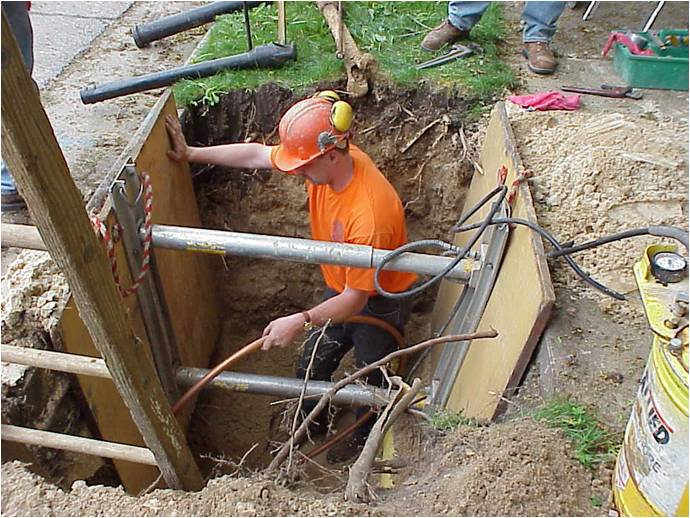As municipalities and water systems look to replace lead service lines, many have examined the technical and cost-benefits of copper versus plastics as a replacement choice, and have chosen copper. A survey conducted by CDA of water systems in 45 states, with 155 municipal water utilities responding indicated a clear trend back to the use of copper for water service lines. Of the responding utilities, 66 percent indicated that they have, or have had problems with their plastic service line installations while fewer than 20 percent indicated the same for copper.
What did these utilities say about using copper?
"In the early '80s we used plastic, but it was not a good product. We had to replace it all, at great expense, less than 10 years later. We went back to using copper, and decided we would only use copper from then on." (Vancouver, WA)
"We allow high density polyethylene as a cost concession to developers. We use copper for everything the Utility installs because the Maintenance Division insists on it. We would much prefer to have only copper used." (Charlotte, NC)
"[We choose copper] because we had an instance where gasoline migrated through PE pipe." (Rochester, NY)
"We allowed high density polyethylene for around 10 years; we recently stopped allowing it because of our history of failures with it. Whole subdivisions have had to be torn up to remove it."
"Historically, copper has been the best material. When we used polyethylene and polybutylene, we had problems." (Little Rock, AR)
"We moved to copper in the 1940s. It has been a good material... material of choice... In the 1980s, we used high density polyethylene which regularly developed leaks. We stopped using it, and are replacing now with copper." (Richmond, VA)
These comments are echoed from city to city, from large to small. Santa Cruz, California, Seattle, Washington and representatives from water utilities in other cities across the U.S. cited their systematic replacement of thousands of plastic service lines throughout their systems. The common reason cited for why their utility tried plastics was its low material cost. It is clear that many tried this route only to find it offered a false economy, and then returned to copper.
 Photo courtesy: Madison Water Utility
Photo courtesy: Madison Water UtilityMore recently, Lansing, Michigan; Flint, Michigan; Madison, Wisconsin; Milwaukee, Wisconsin; Green Bay, Wisconsin; Louisville, Kentucky; St. Paul, Minnesota; Sandusky, Ohio; Cincinnati, Ohio; Washington, DC; and Spokane, Washington among many others have chosen copper as the right choice for lead service line replacements.
- Lansing, Michigan: City owned utility with 55,000 water customers is nearing the end of a large-scale plan to improve the infrastructure of their water system by replacing 13,500 of the 14,000 lead pipes with copper.
- Flint, Michigan – All lead lines will be replaced with new copper lines. Officials in Flint are not taking any chances; they have already begun replacing all of the city's lead pipes with copper.
- Madison, Wisconsin initiated its own replacement programs 15 years ago using copper. The state capital replaced more than 8,000 of its lead lines with copper from 2001-2011 after discovering lead levels over the federal limit. Instead of making minor changes and pushing a potential problem to future generations, city officials took action despite public pushback.
- Milwaukee, Wisconsin has hurriedly begun removing all lead pipes or laterals and replacing them with copper. It is estimated that the city has about 70,000 lead service lines.
- Louisville, Kentucky began replacing its lead service lines with copper pipes in the late 1990s as part of a scheduled lead replacement program. The city will replace approximately 1,000 lead service lines in 2016. The goal is to finish replacing a ll the lead lines by 2025.
- St. Paul, Minnesota—looking to replace all of its 14,000 lead water service lines with copper—a move they hope to complete over the next two decades. The project is currently ongoing. Initially, they were required by the EPA Lead and Copper Rule to remove 7 percent of the lead lines for three consecutive years, but decided to continue the replacement project to ensure no further contamination.
- Spokane, Washington opted to replace its remaining 486 lead lines with copper over the next two to three years. This makes up less than 1 percent of the city's 75,000 service connections. Spokane had nearly 1,000 lead service lines at one time, but the city opted to replace them as they were uncovered during work on the system.
Canadian cities such as Toronto, Montreal, Ottawa, London and Winnipeg have also been steadily working on replacing lead service lines with copper. The city of Montreal announced in 2007 the start of a multi-year program to replace approximately 75,000 lead services supplying water to residences of less than eight units built before 1970. Toronto is in the midst of a program to replace about 140,000 lead or galvanized steel services. The common factor in many of these programs is a consistent, deliberate choice to replace with copper for long-term reliability of this hard-to-reach, hard-to-replace infrastructure—favoring life-cycle value over short-term cost.
